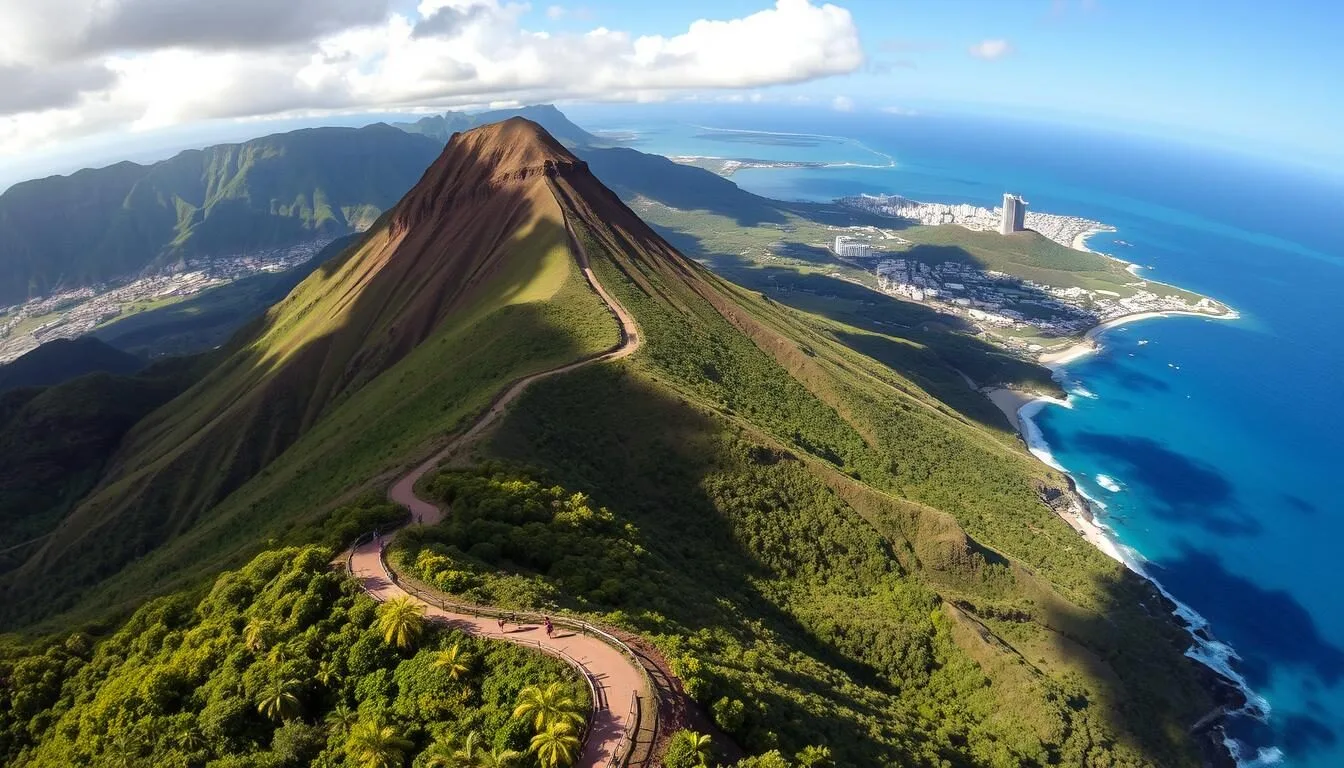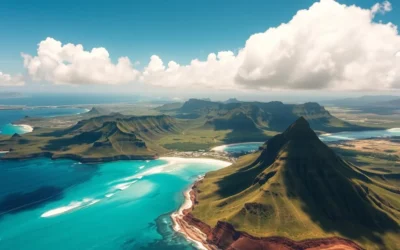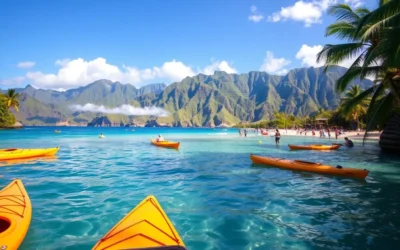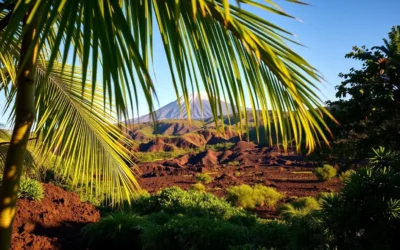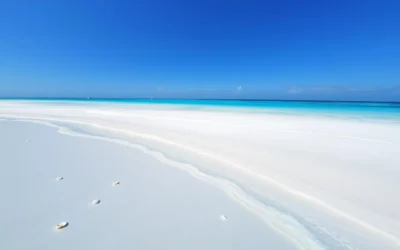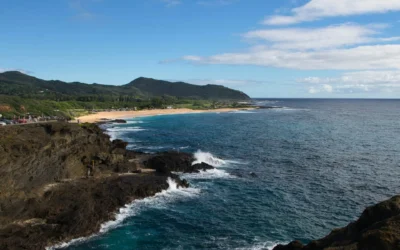✓ Accommodations ✓ Flights ✓ Rental Cars ✓ Tours & Activities
As you plan your trip to Oahu, Hawaii, one iconic landmark that should be at the top of your list is the Diamond Head State Monument. This stunning volcanic crater is not only a must-visit destination but also a significant cultural and historical site.
You’ll be drawn to the unique profile of Diamond Head, known as Lē’ahi, which sits prominently near Waikiki’s coastline. The monument encompasses over 475 acres, offering a rich geological history, cultural significance, and breathtaking coastal views.
Whether you’re planning to hike to the summit or simply want to experience this natural wonder, our guide provides you with essential visitor information to make the most of your trip.
Diamond Head State Monument: An Overview
The Diamond Head State Monument is a testament to the volcanic origins of the Hawaiian Islands, with its formation dating back approximately 300,000 years. This iconic landmark is a 760-foot-tall tuff crater that has become a symbol of Hawaii.
![]()
Geological Formation and History
Diamond Head was formed during a single, explosive eruption about 300,000 years ago. The eruption sent ash and fine particles into the air, which eventually settled and cemented together into a rock called tuff, creating the crater. The geological formation is part of the Honolulu Volcanic Series, a system that includes dikes, lava flows, and tuff cones that shaped this part of Oahu.
| Geological Feature | Description |
|---|---|
| Tuff Crater | Formed from the cementation of ash and fine particles |
| Honolulu Volcanic Series | A system of dikes, lava flows, and tuff cones |
| Eruption | Occurred approximately 300,000 years ago |
Cultural Significance and Name Origin
The name “Diamond Head” was given by British sailors in the 18th century, who mistook calcite crystals on the crater slopes for diamonds. However, the native Hawaiians called it “Lē’ahi,” which refers to the brow of the ahi fish or possibly to navigational fires once lit along the shoreline. The monument has played a significant role in Hawaiian history, from its importance to native Hawaiians to its later use as a military lookout.
Today, Diamond Head State Monument encompasses over 475 acres, including the interior crater and outer slopes. It was designated as a National Natural Landmark in 1968, recognizing its natural and cultural significance.
Essential Visitor Information for Diamond Head State Monument
![]()
To ensure a smooth and enjoyable experience at Diamond Head State Monument, familiarize yourself with the monument’s operating hours, fees, and reservation requirements.
Operating Hours and Seasonal Closures
Diamond Head State Monument has specific operating hours that vary depending on construction projects and seasonal considerations. Currently, rockfall mitigation construction is affecting park access through September 5, 2025. During normal operations, the park is open daily from 6:00 am to 6:00 pm, with the last entry at 4:00 pm and gates closing promptly at 6:00 pm.
The monument observes annual closures on Christmas Day and New Year’s Day, so plan your visit accordingly if traveling during the holiday season.
Entrance and Parking Fees
Entry fees are required for non-Hawaii residents ($5 per person), while Hawaii residents can enter free with valid state ID or driver’s license, and children 3 and under are admitted free regardless of residency. Parking fees are separate from entry fees, with non-resident vehicles charged $10 per vehicle, while residents with proper ID can park at no additional charge.
Payment for both entry and parking is by credit card only.
Reservation Requirements
As of May 2022, advance reservations are mandatory for all non-Hawaii residents and must be made up to 30 days in advance through the official online reservation system. Visitors must arrive within 30 minutes of their reserved time slot to maintain their reservation.
Commercial vehicles have different fee structures based on passenger capacity, ranging from $25 for 1-7 passenger vehicles to $90 for vehicles carrying 26 or more passengers.
Hiking the Diamond Head Summit Trail
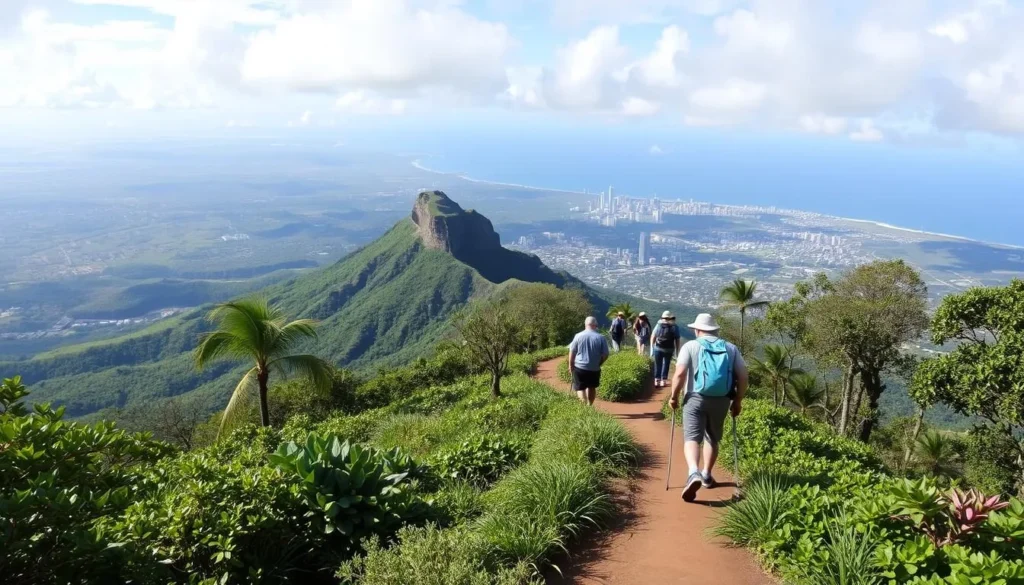
As you prepare to hike the Diamond Head Summit Trail, you’ll embark on a journey through one of Hawaii’s most iconic natural landmarks. The trail, which was built in 1908 as part of O’ahu’s coastal defense system, offers a unique blend of geological and military history.
Trail Description and Difficulty Level
The Diamond Head Summit Trail is a 0.8-mile trek that takes hikers from the crater floor to the summit, gaining 560 feet in elevation. The moderately challenging route is characterized by steep stairs and a lighted tunnel, making it an exciting adventure for those who undertake it. The trail surface transitions from a concrete walkway to a natural tuff surface, adding to the hike’s varied terrain.
What to See Along the Trail
As you ascend, you’ll encounter historic military bunkers, a navigational lighthouse, and panoramic views spanning from Koko Head to Wai’anae. The trail’s summit offers a glimpse into the geological formation and military history of Diamond Head crater, making it a fascinating experience for history buffs and nature lovers alike. During winter months, you might even spot humpback whales passing in the distance.
Hiking Tips and Safety Information
To ensure a safe and enjoyable hike, wear comfortable walking or hiking shoes with good traction, as parts of the trail can be uneven, steep, and potentially slippery. Allow 1.5 to 2 hours to complete the round-trip journey, accounting for time to enjoy the views and explore the summit area.
Planning Your Visit to Diamond Head
With a little planning, your visit to Diamond Head can be a truly unforgettable experience. To ensure that you’re well-prepared for your trip, consider the following information.
How to Get to Diamond Head from Waikiki
There are multiple ways to reach Diamond Head from Waikiki. You can take a scenic 45-minute walk along the shoreline, drive east for about three miles (with a $10 parking fee per vehicle for non-residents), or use public transportation such as TheBus numbers 2 or 23, or the Green Line of the Waikiki Trolley.

Best Times to Visit
The best times to visit Diamond Head are early in the morning (6:00-8:00 am) or late in the afternoon (2:00-4:00 pm). These times allow you to avoid the midday sun and heat, as well as the crowds that come with it. Weekdays are also a good option if you have a flexible schedule, as they tend to be less busy than weekends.
What to Bring and Wear
When visiting Diamond Head, it’s essential to bring plenty of water (at least one bottle per person) and wear comfortable, closed-toe shoes with good traction. You should also protect yourself from the sun with sunscreen, sunglasses, and a hat. Consider packing light snacks, a camera, and a small backpack to carry your essentials.
Dress in lightweight, breathable clothing suitable for warm weather, but also bring a light jacket or windbreaker as it can be breezy at the summit, especially in the early morning or evening hours.
Making the Most of Your Diamond Head Experience
With over 3,000 visitors daily, making the most of your Diamond Head visit requires some insider knowledge. To enhance your experience, consider purchasing the Diamond Head Audio Tour ($5) online or at the interpretive kiosk, which provides fascinating insights into the crater’s 300,000-year geological history.
You can further enrich your visit by joining a guided ranger tour, available by email reservation. This expert commentary will help you appreciate Diamond Head’s formation and its role in Hawaii’s coastal defense system.
- Allow extra time at the summit to appreciate the spectacular 360-degree views.
- Pack a picnic lunch to enjoy at one of the designated rest areas within the park.
- Explore the historic military installations at the summit.
By planning ahead, making reservations in advance, and arriving early, you can ensure a memorable and enjoyable experience at this iconic landmark.
The above is subject to change.
Check back often to TRAVEL.COM for the latest travel tips and deals.
